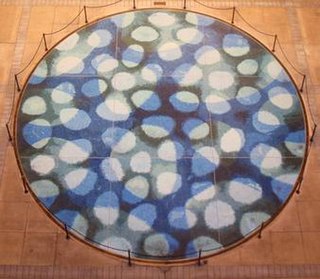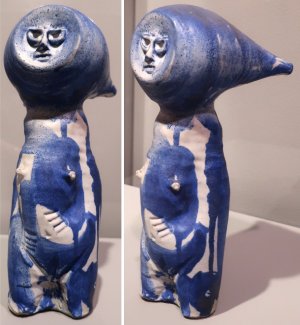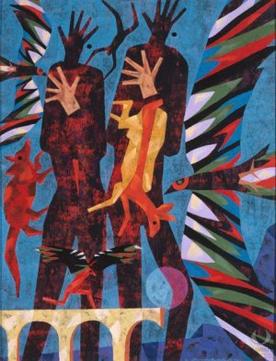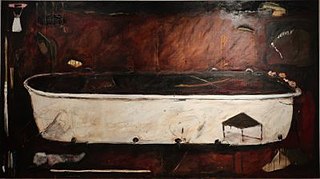Michael Tom (1946–1999) was an American sculptor.
Michael Tom (1946–1999) was an American sculptor.
Tom was born and raised in Honolulu, Hawaii. Tom was adopted and named as Michael Goon Bing Tom. Tom's sister is Crystella. [1]
In 1971, Tom received a Bachelor of Fine Arts degree in painting and metalsmithing from Sonoma State University in Rohnert Park, California, and pursued graduate studies at San Diego State University. [1]
Tom started his career as a teacher for students with special needs. [1]
Tom started his artistic career as a painter, but was then drawn to making art jewelry. Art jewelry led to metalsmithing, which in turn led to metal and mixed media sculpture.
In 1992, Tom was the recipient of the second Catharine E. B. Cox Award for Excellence in the Visual Arts and has a solo exhibition at the Honolulu Academy of Arts [2] Tom is best known for his small sculptures of hammered copper. Death is a pervasive theme in his work (Clark, 1996).
Some of his sculptures are anthropomorphic, referencing birth, war, and death. [3] Man: b. 1910-d. 1969/Woman: b. 1914-d. 1974, in the collection of the Hawaii State Art Museum, demonstrates the artist's anthropomorphic work. The East-West Center, the Hawaii State Art Museum, and the Honolulu Museum of Art and they are among the public collections holding sculptures by Michael Tom.
Tom's second wife was Pamela Simon. [1] On April 12, 1999, Tom died of liver cancer in Honolulu, Hawaii. He was 52 years old. [1]

The Honolulu Museum of Art is an art museum in Honolulu, Hawaiʻi. The museum is the largest of its kind in the state, and was founded in 1922 by Anna Rice Cooke. The museum has one of the largest single collections of Asian and Pan-Pacific art in the United States, and since its official opening on April 8, 1927, its collections have grown to more than 55,000 works of art.

Masami Teraoka is an American contemporary artist. His work includes Ukiyo-e-influenced woodcut prints and paintings in watercolor and oil. He is known for work that merges traditional Edo-style aesthetics with icons of American culture.

Tadashi Sato was an American artist. He was born in Kaupakalua on the Hawaiian island of Maui. His father had been a pineapple laborer, merchant, and calligrapher, and Tadashi's grandfather was a sumi-e artist.

Satoru Abe is a Japanese American sculptor and painter.
Alan Leitner is an American abstract artist. He was born in 1947 in an ethnically diverse section of Los Angeles. Alan was the middle of three children in a Jewish family. He received his B.S. in art in 1971 from Woodbury University in Los Angeles, where he met his first wife who wanted to move to Hawaii. Also in 1971, he acquired an art foundry that produced blown glass, sculpture, ceramics and paintings, which contributed greatly to his understanding of art. In 1987, he received a M.F.A. in painting from the University of Hawaii at Manoa. The graduate program required students to do some teaching, and through this teaching he met Alyn Brownley who at the time headed the art program at Leeward Community College. Brownley requested Alan to teach her art class for one semester while she pursued a move to University of Hawaii at Manoa. After graduation, Dr. John Conner, the department associate dean, offered Alan a full-time teaching position at Leeward Community College, where he is currently a professor. Alan has also taught at Honolulu Community College and University of Hawaii at Manoa.
Tetsuo Ochikubo (1923–1975), also known as Bob Ochikubo, was a Japanese-American painter, sculpture, and printmaker who was born in Waipahu, Hawaii, Honolulu county, Hawaii. During the Second World War, he served with the 100th Battalion of the 442nd Regimental Combat Team. After being discharged from the Army, he studied painting and design at the School of the Art Institute of Chicago and at the Art Students League of New York. In 1953, he spent a year in Japan, studying traditional brush painting and connecting with his ancestry. He worked at Tamarind Institute in the 1960s and is best known for his entirely abstract paintings and lithographs. Along with Satoru Abe, Bumpei Akaji, Edmund Chung, Jerry T. Okimoto, James Park, and Tadashi Sato, Ochikubo was a member of the Metcalf Chateau, a group of seven Asian-American artists with ties to Honolulu. Ochikubo died in Kawaihae, Hawaii in 1975.
David Kuraoka is an American ceramic artist. He was born in Lihue, Hawaii, grew up on the island of Kauai, Hawaii in Hanamaulu and Lihue, and graduated from Kauai High School in 1964. Kuraoka spent his formative years in Hanamaulu where he lived with his parents in his paternal grandmother's home in a plantation labor camp. His father, one of seven children and the only son, became a journalist, writing a weekly column published on Wednesdays, and the Kauai campaign manager for local politician Hiram Fong and Richard Nixon. His mother, Emiko Kuraoka, was a school teacher. He is married to Carol Kuraoka. Kuraoka moved to California in 1964 to study architecture at San Jose City College, eventually transferring to San José State University where he received his BA in 1970 and MA 1971. After completing graduate work that focused on ceramics, Kuraoka joined the faculty at San Francisco State University, eventually rising to head its ceramics department.

Claude Horan was an American ceramic and glass artist who was born in Long Beach, California. He received a BA from San Jose State University in 1942 and an MA degree in art from Ohio State University in 1946. His wife Suzi Pleyte Horan collaborated on many of the larger projects. He was a lifeguard and longboard surfer in Santa Cruz in the late 1930s, and is credited with naming Steamer Lane.
Leland Miyano is an artist, landscape designer and author born and raised in Hawaiʻi. He received his Fine Arts degree from the University of Hawaiʻi at Mānoa.
The Catharine E. B. Cox Award for Excellence in the Visual Arts is a biennial award given to a visual artist who is a former or current resident of Hawaii. The recipient may work in any medium, and is honored with a solo exhibition at the Honolulu Museum of Art. The award was established in 1985 by Charles S. Cox of La Jolla, California, Doak C. Cox of Honolulu and Richard H. Cox of Honolulu to honor their grandmother, Catharine Elizabeth Bean Cox.
Gary Lee Noffke is an American artist and metalsmith. Known for versatility and originality, he is a blacksmith, coppersmith, silversmith, goldsmith, and toolmaker. He has produced gold and silver hollowware, cutlery, jewelry, and forged steelware. Noffke is noted for his technical versatility, his pioneering research into hot forging, the introduction of new alloys, and his ability to both build on and challenge traditional techniques. He has been called the metalsmith's metalsmith, a pacesetter, and a maverick. He is also an educator who has mentored an entire generation of metalsmiths. He has received numerous awards and honors. He has exhibited internationally, and his work is represented in collections around the world.

Tom Joyce is a sculptor and MacArthur Fellow known for his work in forged steel and cast iron. Using skills and technology acquired through early training as a blacksmith, Joyce addresses the environmental, political, and social implications of using iron in his work. Exhibited internationally since the 1980s, his work is included in 30-plus public collections in the U.S. and abroad. Joyce works from studios in Santa Fe, New Mexico, and since 2012, in Brussels, Belgium, producing sculpture, drawings, prints, photographs, and videos that reference themes of iron in the human body, iron in industry, and iron in nature.

Jason Jun Teraoka is a figurative painter who was born in Kapaʻa, Hawaiʻi. He is a fourth-generation Japanese-American who lives and works in Honolulu, and is largely self-taught. In 2000, he received the Hawaii State Foundation on Culture and the Arts Arts Acquisition Award, and in 2001 he received the Reuben Tam Award for Painting from the Honolulu Museum of Art.
Kenneth Wayne Bushnell was an American visual artist, who was born in Los Angeles. He earned a BA from the University of California, Los Angeles in 1958, and then moved to Hawaii, where he received an MFA from the University of Hawaiʻi in 1961. He taught painting at the University of Hawaiʻi at Mānoa from 1961 to 1981, and was appointed chairman of the Art Department in 1991. He married fellow artist Helen Gilbert in 1995. Bushnell eventually earned the title of professor emeritus, living in Honolulu.
Sanit Khewhok is a painter, sculptor, curator, and conservator.
Kaili Chun is a Native Hawaiian sculptor and installation artist. She also is a lecturer at Kapi'olani Community College. Her works frequently address Hawaiian culture and history as well as the effects of Westernization. Natural and industrial materials are also common in her artworks.
Myra Mimlitsch-Gray is an American metalsmith, artist, critic, and educator living and working in Stone Ridge, New York. Mimlitsch-Gray's work has been shown nationally at such venues as the John Michael Kohler Arts Center, Museum of the City of New York, Metropolitan Museum of Art, Cooper-Hewitt Smithsonian Design Museum, and Museum of Arts and Design. Her work has shown internationally at such venues as the Middlesbrough Institute of Modern Art, Stadtisches Museum Gottingen, and the Victoria and Albert Museum, and is held in public and private collections in the U.S, Europe, and Asia.

Murray Turnbull (1919–2014) was an American artist and art educator, but is best known as the founder of the East–West Center in Honolulu. He was born in Sibley, Iowa. He received a BFA from the University of Nebraska in 1941 and an MA from the University of Denver in 1949. In 1954, he began teaching at the University of Hawaii In 1959, while acting dean of the university's College of Arts and Sciences, Turnbull first proposed an "international college" for all the peoples of Asia and the Pacific. The idea was advanced by Hawaii's delegate to the U.S. House of Representatives John A. Burns, who, with the help of Senate Majority Leader Lyndon B. Johnson, obtained federal funding for an international university in Hawaii, now known as the East–West Center. Turnbull retired from the University of Hawaii as a professor emeritus in 1985.
Linda Threadgill is an American artist whose primary emphasis is metalsmithing. Her metal work is inspired by forms of nature and the interpretations she gleans from the intricate patterns it presents. She explores the foundation of nature to allude to nature and transform it into re-imagined, stylized plants forms.

Dorothy A. Faison also Dorothy Ries Faison is an American artist who was born in Schenectady, New York. She lived in Central and South America from age six to age twelve, because her stepfather worked for the United States Agency for International Development. Her family returned to the United States in 1968, and settled in Hawaii. She received a bachelor of fine arts degree from the University of Hawaii at Manoa in 1977 and earned a master of fine arts degree from the Otis Art Institute in 1979. In 1990, Dorothy Faison was the recipient of the first Catharine E. B. Cox Award for Excellence in the Visual Arts and has a solo exhibition at the Honolulu Academy of Arts. As of 2017 she lives and works in Dordogne, France, with her filmmaker husband, Simon Holland.